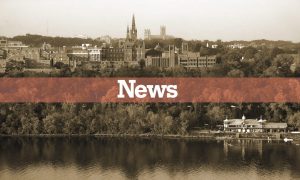The Georgetown University Medical Center and Georgetown University Law Center have partnered to form the Georgetown University Health Justice Alliance, a collaboration between the two centers and their training programs. The alliance will work to increase health equity in D.C. area, bridging disparities across race and class barriers.
“The Alliance is training the next generation of doctors and lawyers to work together to collaborate in pursuit of improved health and greater justice for those living in poverty,” William Treanor, executive vice president and dean of Georgetown University Law Center, wrote in an email to the Voice.
Dr. Edward Healton, executive dean of GUSOM, explained the multi-pronged approach of the Health Justice Alliance— service, education, research, and policy advocacy. These factors work to address what the alliance identifies as social determinants of health— factors which are not explicitly medical in definition but contribute greatly to a patient’s health.
The first prong of the alliance’s approach is service: connecting students with D.C. residents to address problems with insurance, housing, and environmental issues, among other issues. Healton explained that the HJA could be useful for services such as securing time off for employees to seek medical treatment and securing safe housing for asthma patients.
Vicki Girard, a professor at the Law Center and co-founder of the alliance, was excited about the contributions law students would make in the medical setting. “Starting in the fall, we’ll be launching a law clinic which is essentially a model that will put law students in the healthcare clinic setting and working with the doctors and the med students there,” said Girard. “[The students will] be training the healthcare professionals on how to screen for legal issues.”
The alliance will also focus on education. Many of its initiatives, such as the Hoya Clinic which serves homeless and uninsured patients, are staffed by medical and law students with faculty supervision. Healton and Girard believe the interdisciplinary nature of this work will provide a valuable learning opportunity for medical and law students.
“There are medical students and law students who are working in this environment and developing the next generation of leaders in medicine and law who will be aware of each other’s fields and how important they are when it comes to overall healthcare,” Healton said.
The alliance provides hands-on experience for both the medical and legal students involved. Girard emphasized the value of this work, saying that it would give graduates of GUSOM and Georgetown University Law Center a path to continue work in health equity.
Treanor and Girard discussed involvement of undergraduate students in the initiative, including a plenary session, poster presentation, and plans to develop classes on the interactions of medicine and law in the School of Nursing and Health Studies.
“It would be great if we could come up with some joint community projects where undergraduate students could be integrated as well,” said Girard. “I think it could give people who have a social justice interest the opportunity to see: What does it look like to practice law in that context? Or practice medicine? For people who are pre-law or pre-med, it could be a really valuable learning experience.”
Treanor and Girard stated that there was a need for such a partnership at Georgetown due to the prevalence of healthcare disparities in D.C. “Georgetown has long-recognized that health justice is a cornerstone of racial justice: the pathway to equity requires equal access to the resources and services necessary to realize good health and well-being. Washington D.C. has some of the highest health disparities in the country,” Treanor wrote.
The faculty believed that Georgetown was uniquely qualified to address this disparity. Girard said that Georgetown’s access to an outstanding medical and legal center would open additional opportunities for the alliance, allowing Georgetown to take on larger projects with the alliance and also mentor other universities who aim to establish similar programs.
Healton is optimistic about the future of the alliance. “I think we have the chance to be a leader in this area and hopefully make a big difference in health equity,” Healton said. “I think it’s just important to understand how exciting this is and the opportunity that we have to make a difference in the outcome of care and education.”





